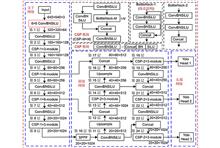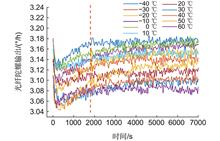 View fulltext
View fulltext
Biomolecules with different chirality have different or even opposite biological and pharmacological activities. Since vibration and rotation energy levels of many biomolecules lie within the terahertz range, terahertz spectroscopy has emerged as a useful tool for biomolecular identification. Nevertheless, linearly polarized light sources are used in terahertz time-domain spectroscopy, which is ineffective for identifying chiral compounds. We theoretically constructed a circularly polarized Jones matrix using a linearly polarized Jones matrix model. We also calculated the transmission circular dichroism spectrum of the sample based on the difference in transmittance of circularly polarized light, offering a useful technique for describing various chiral compounds. The spectra of (R)-(-)-Ibuprofen and (S)-(+)-Ibuprofen were investigated using a transmission terahertz time-domain spectroscopy system, and the linear polarization biased transmittance and circular polarization transmittance of (R)-(-)-Ibuprofen and (S)-(+)-Ibuprofen were computed. Additionally, the transmittance circular dichroic spectra were calculated, and the two chiral compounds' circular dichroic values reached 0.015, successfully achieving the (R)-(-)-Ibuprofen and (S)-(+)-Ibuprofen recognition effect. This technique serves as a guide for chiral molecule identification and detection using terahertz spectroscopy technology.
An improved YOLOv5s network for defects detection for the cable surface of cable-stayed bridge fast and accurately is proposed. This overcomes the problems of low efficiency and poor safety of manual inspection, slow and inaccuracy of existing target detection methods because of the interference of dirt leading to wrong and missed detections. The TRANS module is added to the backbone network of conventional YOLOv5s to obtain more features of a single image and improve defect detection accuracy. Moreover, the CSP module of the neck network is replaced by the GhostBottleneck module and ordinary convolution is replaced by depth-separable convolution to reduce parameters and improve the computational speed of the network. Furthermore, the SIOU loss function is used for suppressing the oscillation of the bounding box and improving the calculation accuracy of repeatability between the prediction and the real box, which can increase the model stability. The experiments show that mAP and FPS of improved YOLOv5s network are 94.26% and 68 frames per second, respectively. The performance is better than that of Faster-RCNN, YOLOv4, and conventional YOLOv5, and it can find the surface defect for the cable of the cable-stayed bridge accurately and timely.
In response to the problem of the large parameter size of semantic segmentation networks, making it difficult to deploy on memory-constrained edge devices, a lightweight real-time semantic segmentation algorithm is proposed based on BiLevelNet. Firstly, dilated convolutions are employed to augment the receptive field, and feature reuse strategies are integrated to enhance the network's region awareness. Next, a two-stage PBRA (Partial Bi-Level Route Attention) mechanism is incorporated to establish dependencies between distant objects, thereby augmenting the network's global perception capability. Finally, the FADE operator is introduced to combine shallow features to improve the effectiveness of image upsampling. Experimental results show that, at an input image resolution of 512×1024, the proposed network achieves an average Intersection over Union (IoU) of 75.1% on the Cityscapes dataset at a speed of 121 frames per second, with a model size of only 0.7 M. Additionally, at an input image resolution of 360×480, the network achieves an average IoU of 68.2% on the CamVid dataset. Compared with other real-time semantic segmentation methods, this network achieves a balance between speed and accuracy, meeting the real-time requirements for applications like autonomous driving.
This paper proposes a novel method of compensating for the fiber optic gyroscope (FOG) temperature drift at full temperatures: the temperature field inside the NFS is constructed by multiple temperature variables, which are composed of the thermometer information built in the three inertial sensors, and then the support vector regression (SVR) is used to describe the relationship between the multiple temperature variables and the temperature drift error of the FOG, and finally the sparrow search algorithm (SSA) is applied to tune the model parameters to improve the accuracy and generalization capability. The experimental results validate the effectiveness of the proposed method, and we improve the accuracy of the NFS start-up stage from 0.0209° to 0.0101°. The performance is closely comparable to that of the stable stage, and improves the fast response capability of NFS at different initial temperatures.
An improved spatio-temporal graph convolutional network for video anomaly detection is proposed to accurately capture the spatio-temporal interactions of objects in anomalous events. The graph convolutional network integrates conditional random fields, effectively modeling the interactions between spatio-temporal features across frames and capturing their contextual relationship by exploiting inter-frame feature correlations. Based on this, a spatial similarity graph and a temporal dependency graph are constructed with video segments as nodes, facilitating the adaptive fusion of the two to learn video spatio-temporal features, thus improving the detection accuracy. Experiments were conducted on three video anomaly event datasets, UCSD Ped2, ShanghaiTech, and IITB-Corridor, yielding frame-level AUC values of 97.7%, 90.4%, and 86.0%, respectively, and achieving accuracy rates of 96.5%, 88.6%, and 88.0%, respectively.
Given that small targets are predominant in the steel surface defect areas, most existing methods cannot balance the trade-off between detection accuracy and speed. In this paper, we propose a steel surface defect detection algorithm based on YOLOv7-tiny (GBS-YOLOv7t). Firstly, we design the GAC-FPN network to fully integrate the target semantic information progressively and across layers, aiming to address the limited information flow issue in traditional feature pyramids. Secondly, we embed a bi-level routing attention (BRA) module to endow the model with dynamic query and sparse perception capabilities, thus enhancing the detection accuracy of small targets. Thirdly, we introduce the SIoU loss function to improve the training and inference capabilities of the model, and to enhance the network robustness. Experimental validation on the public dataset NEU-DET demonstrates an mAP of 72.9% and a precision of 69.9% for GBS-YOLOv7t, achieving improvements of 4.2% and 8.5%, respectively, over the original YOLOv7-tiny model. The FPS reaches 104.1 frames, indicating strong real-time performance. Compared to other detection algorithms, GBS-YOLOv7t is more effective in detecting small targets in steel surface areas, with experimental results showing that the improved algorithm better balances the detection accuracy and speed.
To sparse semantics and enhance attention to key features, enhance the correlation between spatial and local features, and constrain the spatial position of features, this paper proposes a sparse feature image classification network with spatial position correction (SSCNet) for spatial position correction. This network is based on the ResNet-34 residual network. Firstly, a sparse semantic enhanced feature (SSEF) module is proposed, which combines depthwise separable convolution (DSC) and SE to enhance feature extraction ability while maintaining the integrity of spatial information; Then, the spatial position correction symmetric attention mechanism (SPCS) is proposed. SPCS adds the symmetric global coordinate attention mechanism to specific positions in the network, which can strengthen the spatial relationships between features, constrain and correct the spatial positions of features, and enhance the network's perception of global detailed features; Finally, the average pooling module (APM) is proposed and applied to each residual branch of the network, enabling the network to more effectively capture global feature information, enhance feature translation invariance, delay network overfitting, and improve network generalization ability. In the CIFAR-10, CIFAR-100, SVHN, Imagenette, and Imagewood datasets, SSCNet has shown varying degrees of improvement in classification accuracy compared to other high-performance networks, proving that SSCNet can better extract local detail information while balancing global information, with high classification accuracy and strong generalization performance.
To address the challenges faced by drones during UAV (unmanned aerial vehicle) photography in adverse conditions, such as low image recognition, obstruction by obstacles, and significant feature loss, a novel algorithm named SSG-YOLOv7 was proposed to enhance object detection from the perspective of drones in complex environments. Firstly, 12803 images were augmented from the VisDrone2019 dataset, and 1320 images were augmented from the RSOD dataset to simulate five different environments. Subsequently, anchor box sizes suitable for the datasets were clustered. The 3D non-local attention mechanism SimAM was integrated into the backbone network and feature extraction module to enhance the model's learning capabilities. Furthermore, the feature extraction module SPPCSPC was restructured to integrate information extracted from channels with different pool sizes and introduce the lightweight convolution module GhostConv, thereby improving the precision of dense multi-scale object detection without increasing the model's parameter count. Finally, Soft NMS was employed to optimize the confidence of anchor boxes, reducing false positives and missed detections. Experimental results demonstrate that SSG-YOLOv7 exhibits superior detection performance in complex environments, with performance metrics VisDrone~~mAP@0.5 and RSOD~~mAP@0.5 showing improvements of 10.45% and 2.67%, respectively, compared to YOLOv7.
In order to reduce the amount of waste metal produced by nuclear power plants, a new technology for clean control or reuse of radioactively contaminated metal components is been studied. In this study, laser composite decontamination technology was proposed for corroded 4140 steel, and compared with dry ice decontamination and laser decontamination alone. By testing the microstructure, composition distribution, metallographic structure, and three-dimensional morphology of the matrix sample, the variation trend of surface roughness and microhardness was analyzed to determine the composite decontamination effect. Finally, the engineering verification was realized in the nuclear power plant. The test and verification results show that the laser composite decontamination technology can completely remove the rust layer on the surface of 4140 steel and obtain the best decontamination effect. Furthermore, it does not affect the composition, microstructure, and mechanical properties of the matrix material. The average amount of sewage on the surface of the contaminated motor impeller after decontamination is less than 0.4 Bq/cm2, and the surface contact dose rate is less than 40 nSv/h, which meets the clearance level of solid waste in nuclear power plants. Thus, laser composite decontamination technology can provide a new method for decontamination of radioactively contaminated metal components in nuclear power plants and minimize waste.














